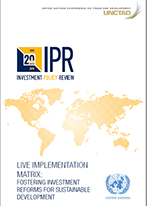The investment landscape has significantly changed over the past decades. The continuous surge in foreign direct investment (FDI) that characterized the three decades preceding the 2008 financial and economic crisis came to a halt. This is due to the crisis itself and also to evolving patterns of international production, stagnating growth in global value chains (GVCs) and decreasing rates of return on investment. Added to the outbreak of the COVID-19 pandemic and following a declining trend since 2016, estimates showed that FDI flows are expected to decrease by close to 50 per cent in 2020, with a possible rebound in 2022 in the best case scenario after an additional decrease in 2021 (UNCTAD, 2020).
The competition for international investment will increase. The estimated investment gap is sizable, computed at $2.5 trillion dollars annually (UNCTAD, 2014).2 As the main source of external financing in developing countries, FDI will continue to play a key role in supporting countries’ efforts to achieve the Sustainable Development Goals (SDGs) and in better integrating in an evolving world. Given the significant decline in global FDI flows and the increasing needs of countries to finance their sustainable development projects, the competition for attracting more investment will further increase. For countries to successfully position themselves, including in a changing trade and investment landscape, there will be a need to speed up reforms, adapt policies and strategies, and adopt new ways of doing business that are more in adequation with these financing needs.
Countries will need to boost their capacities to drive, monitor and evaluate investment climate reforms. This is likely to be even more relevant for developing economies, where sound and coherent investment policies will increasingly become essential to build investors’ confidence and maintain the economies’ attractiveness. In addition, relevant agencies will need to adopt responsive investment promotion strategies. As the need and speed of reforms increase, tracking progress will become essential to assess their impact, reevaluate and adjust them where necessary, and ensure their effectiveness.
The objective of this document is twofold: it aims to explore some of the policy tools, strategies and mechanisms put in place by countries to advance investment policy reforms, and to highlight practices and initiatives which could be successfully replicated. The study also presents a new interactive tool developed by UNCTAD – the Live implementation matrix.
The tool will assist countries to keep track of the progress made in implementing the recommendations of UNCTAD’s Investment Policy Reviews (IPRs), and to better support them in achieving their sustainable development objectives.

